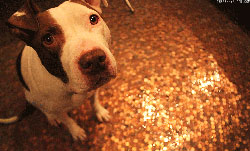How many pennies does it take to tile a bedroom floor?
In the case of one crafty Chicago couple, about 60,000. Their mantra: “They say it takes a village. We say it takes a bottle of wine and some OCD.”
It might be an unusual way to save on home furnishing costs in an extremely tough economy – but overall the project cost the couple, Ryan Lange and Emily Belden, about $1,000. They say they’d been “looking up options [for their bedroom floor] and were thinking about being green” – then decided to go the penny route after Lange, an entrepreneur and self-described design “freak,” suggested they “just tile the floor in pennies,” starting with a long-ignored jar of pennies. 
Belden, a freelance copy editor, says she wasn’t sold on the notion at first – but then “came home one day and found a small corner done, so I thought, ‘I guess we’re doing it,’” she recalled.
The painstaking coin work took four months and 128 hours to cover their 234-square-foot plywood floor, say the couple, who created a blog about their project called thepennyfloor.com.
“We started with small tubes of glue and laid tiny dots on it in a line, similar to the way you would decorate a cake with icing,” they explain on the blog. “Then, we’d place each penny (heads up except for wheat pennies) and push it into place. Maddening, for sure.”
Their “big breakthrough” came when they turned to a caulk gun and stronger glue. They “finalized the project by placing one rare silver penny into the mix of copper. Then, we drowned the floor in a clear coat and cemented the little Lincolns into their final resting place.”
Within the bulk of the pennies were some rare finds, as it turns out: a 1944 WWII steel penny that was created during the war when copper was in high demand, and a 1873 penny featuring the Indian head instead of Abe Lincoln. “Both pennies [were] worth enough money to pay for the project,” reported NBC, “but [still] ended up on the floor.”
Today, the couple has a smooth, shiny floor “that’s fun to walk on and easy on the eyes – not to mention we’re walking on money, people. How cool is that?”
Along the way, they coined a few terms to celebrate their efforts, including:
• Pennying: The act of putting pennies down on the floor one by one. “Best accompanied by Spotify Premium and Pinot Noir,” they write on their blog.
• Penny Glue or “PG”: Collequial term for the glue they used.
• Reruns or Second Sitters: Previously glued pennies that inadvertently popped up and needed to be glued down again.
• Run: Any trip to the bank “involving the purchase of more than $25 in rolls of pennies.”
• Hot Damn Mess: A section of “freshly laid pennies not lining up with previously glued pennies.”
For all their ingenuity, Lange and Belden certainly aren’t the first to create a money-laden DIY floor: Two months ago, a Pittsburgh area tattoo parlor owner claimed to have tiled her floor with 250,000 pennies. “Amazingly enough, it’s a lot cheaper to glue money to your floor than to actually buy tile – it’s about $3 a square foot,” she told ABC News in November.
A website called Design, Dining + Diapers written by a stay-at-home mom, freelancer and blogger who aims to decorate on a budget, also created a list of “10 Ways to Decorate with Pennies (Literally)” last year. The ideas ranged from penny jar candles to penny accent walls and penny countertops.
As for the larger bottom line: Last year it cost the U.S. Mint two cents to make every cent because of materials and production. That’s actually lower than it was the year before, when the cost per penny was nearly 2 ½ cents. For the 2012 fiscal year, the U.S. Mint produced and shipped 5.835 billion cents. The production and distribution of the penny generated a loss of $58 million (which was more than offset by higher denomination circulating coins).
RELATED: 15 Shocking Auction Sales
Pennies that were made between 1959 and 1982 (with Abe Lincoln on the front, the Lincoln Memorial on the back) are composed of 95 percent copper and 5 percent zinc, with a current melt value – as of January 24, 3013 – of $0.0241434. (Pennies made earlier than that, from 1909 to 1958, feature the wheat stalks on the back.)
Specific pennies, of course, can go for a lot more on the open market. On eBay right now, a seller of a 1914-D Lincoln wheat is asking $100 (and has one bid so far as of this afternoon), while another seller has the same penny for sale at $75.
Since 1982, pennies have only been copper plated, not copper throughout. For a brief time during World War II – primarily in 1943 – the Mint made zinc-coated steel pennies, in order to save copper for the war efforts. But a rare bronze cent made in 1943 that was struck at the Philadelphia Mint sold for a whopping $218,500 in an auction in January 2010, according to Coin World.
Now that’s a pretty penny.


